
The saddleback toads (Brachycephalus) are a genus of tiny toads and frogs in the family Brachycephalidae in the order Anura, ranging from south Bahia to Santa Catarina in southeastern Brazil. The genus includes two main groups, the often brightly coloured pumpkin toadlets, and the overall brown and more frog-like flea frogs, which once were placed in their own genus Psyllophryne. Some pumpkin toadlets are toxic and their often bright colours are considered aposematic. At about 1 cm (0.4 in) or less in snout–to–vent length, the flea frogs are some of the smallest frogs in the world.

The Brachycephalidae are a family of frogs confined to eastern and southern Brazil and northern Argentina. The family is composed of two externally quite different genera: the tiny, often colourful and plump saddleback toads (Brachycephalus) from Brazil, and the larger, slimmer and more drab genus Ischnocnema from both Brazil and Argentina. The family is mainly defined by molecular characteristics, and are linked by few anatomical features. It was erected from two genera of the previously large family Eleutherodactylidae, which is now split into four families.
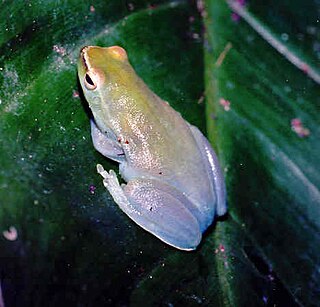
Sphaenorhynchus is a genus of frogs in the family Hylidae. They are also known as lime treefrogs or hatchet-faced treefrogs. They are found in the Amazon and Orinoco River basins of South America, the Guianas, Trinidad, and southern and eastern Brazil. The majority of the species are associated with the Atlantic Forest domain in Brazil.
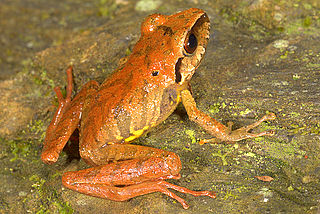
The Eleutherodactylidae are a family of direct-developing frogs native to northern South America, the Caribbean, and southernmost North America. They are sometimes known under the common name rain frogs. Formerly the subfamily Eleutherodactylinae of the family Leptodactylidae, it was raised to the family status following a major revision of New World direct-developing frogs in 2008. As currently defined, the family has more than 200 species.

Adelophryne is a genus of frogs in the family Eleutherodactylidae. They are native to northern South America east of the Andes, known roughly from the area corresponding to the Guiana Shield, as well as to the coastal area of Bahia, Brazil. Whether the genus is truly distinct from Phyzelaphryne remains uncertain. Common name shield frogs has been proposed for this genus, although the stem flea frog is used for some species.

Physalaemus is a large genus of leptodactylid frogs. These frogs, sometimes known as dwarf frogs or foam frogs, are found in South America. It is very similar to Leptodactylus, a close relative, and indeed the recently described Leptodactylus lauramiriamae is in some aspects intermediate between them.

Adenomera is a genus of leptodactylid frogs, sometimes known as tropical bullfrogs, found in South America east of the Andes. The genus was until recently considered a synonym of Leptodactylus.

Leptodactylus is a genus of leptodactylid frogs. It includes the species commonly called ditch frogs or white-lipped frogs. It is very similar to Physalaemus, a close relative, and indeed the 2005 described Leptodactylus lauramiriamae is in some aspects intermediate between them. The name means ‘slender finger’, from leptos and the Greek daktylos.

Chiasmocleis is a genus of microhylid frogs. They are found in tropical South America north and east of the Andes. Their common name is humming frogs or silent frogs, the latter referring to the formerly recognized Syncope.

Oreobates is a genus of frogs in the family Strabomantidae. Most species were formerly in the genus Ischnocnema, but were moved to this revalidated genus following a 2006 revision. Its sister taxon is Lynchius.

Boana is a genus of frogs in the family Hylidae. They are commonly known as gladiator frogs, gladiator treefrogs or Wagler Neotropical treefrogs. These frogs are distributed in the tropical Central and South America from Nicaragua to Argentina, as well as in the Caribbean.

Crossodactylus is a genus of frogs in the family Hylodidae. The genus occurs in Brazil, southern Paraguay, and northern Argentina. These frogs are sometimes known as Limnocharis, Tarsopterus, Calamobates, and by the common name spinythumb frogs. They typically inhabit streams in mountainous areas in the Atlantic Forest or in montane savanna.

Cycloramphus is a genus of frogs in the family Cycloramphidae. The genus is endemic to the southeastern Brazil. They are sometimes known as the button frogs.
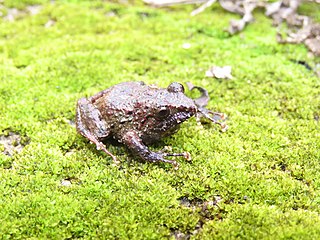
Ischnocnema holti is a species of frog in the family Brachycephalidae. It is endemic to the state of Rio de Janeiro, Brazil, and is known from the Serra da Mantiqueira in Itatiaia and Serra dos Órgãos in Teresópolis. Common name Holt's robber frog has been coined for this species.

Hylodes is a genus of frogs in the family Hylodidae. The genus may be paraphyletic with respect to Megaelosia. The genus Hylodes is endemic to southeastern Brazil. Member species are also known commonly as the tree toads, or more ambiguously, as torrent frogs. They are diurnal and usually inhabit shallow mountain streams.
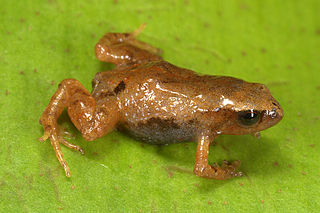
The Strabomantidae are a family of frogs native to South America. These frogs lack a free-living larval stage and hatch directly into miniature "froglets". This family includes Pristimantis, the most speciose genus of any vertebrate.

Craugastoridae, commonly known as fleshbelly frogs, is a family of New World direct-developing frogs. As delineated here, following the Amphibian Species of the World, it contains 129 species. They are found from the southern United States southwards to Central and South America.
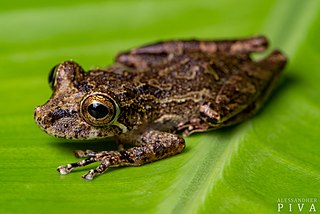
Ololygon is a genus of frogs in the family Hylidae. The majority of species in it are endemic to the Atlantic Forest of eastern Brazil, although the range of some species, including Ololygon aromothyella and Ololygon berthae, is known to extend south to northeastern Argentina, southern Paraguay, and Uruguay.
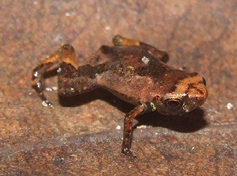
Brachycephalus pulex, also known as the Brazilian flea toad and the Serra Bonita flea toad, is a species of small frogs in the family Brachycephalidae. It is one of more than 35 named species within the genus Brachycephalus. It has been suggested to represent the smallest known vertebrate, with an average snout–vent length of 7.10 millimetres (0.280 in) in mature males.



















